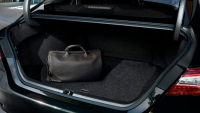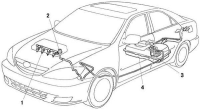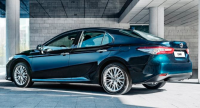The reliability of the vehicle's operation depends on the fuel used. The use of low-quality fuel causes serious problems. Modern electronic control units are able to adapt the powertrain to low-octane petrol by changing the ignition advance angle, but this leads to increased wear on the powertrain components as well as higher consumption.

The volume of the petrol tank is influenced by vehicle size, vehicle weight and capacity. SUVs and trucks have larger fuel tanks than sedans, station wagons or minivans. Regardless of size, the fuel tank requires regular maintenance.
The Camry's tank capacity and fuel consumption are determining and interrelated factors in the reliability of the vehicle's operation.
Gas tank capacity of the Camry
Vehicle reliability is dependent on the fuel used. Use of low-quality fuel raises serious issues. Modern electronic control units are able to adapt the power unit to use low-octane gasoline by changing the ignition advance angle, which leads, however, to increased wear of power unit components as well as increased consumption.

The volume of the petrol tank is influenced by vehicle size, vehicle weight and capacity. SUVs and trucks have larger fuel tanks than sedans, station wagons or minivans. Regardless of size, the fuel tank requires regular maintenance.
Camry tank volume and fuel consumption are determining and interrelated factors in the reliability of the vehicle's operation.
Read also:
Advantages and disadvantages
Rust on the bonnet
An important virtue of the 2013 Camry is reliability. Motors and boxes with proper maintenance and moderate driving style will run long and without problems. The chassis will not require frequent and expensive repairs, main units and assemblies will last more than 100 thousand km. A plus is the soft suspension, which is well suited for rough roads. Toyota's advantages are the demand for used cars on the market and the slow drop in price.

Dented driver's seat roll
The weaknesses of the Toyota Camry XV50 include the soft and thin body paintwork, which is inherent in modern cars. But the main problem is that the car quickly starts to rot in places of chipped paint, sometimes corrosion even reaches the welds in the boot. When picking up a used car, check the boot lid and bonnet for rust first.
The mediocre noise insulation is a shortcoming of the 7th generation. It has improved compared to 2006 Camry, but is still low for a sedan of this size. The level of seat trim is also a disadvantage. The seats sag quickly, the trim stretches and tears. This was often a problem before the warranty expired and was repaired by the dealer. "Crickets" in the cabin are frequent guests, squeaky armrest, front panel, seats...
Gas tank capacity of Camry XV10
The Toyota Camry XV10 tank capacity is 70 litres. According to the manufacturer's specifications, the fuel used is AI-95 petrol. Fuel with an octane number of 95 is recommended for fuelling a Toyota with an automatic transmission or a manual transmission.
On a full tank, the Camry XV10 can travel about 540 km. This figure is an average and depends on the type of road, speed, driving style and a number of other external factors. For example, the fuel consumption of 2.2 5S-FE with automatic transmission under ideal conditions shouldn't exceed 11.2 liters. Actual consumption depends on weather conditions, road surface quality, engine wear and tear etc. The appetite of a petrol 3.0 3VZ-FE may reach the mark of 13.2 liters per one hundredth.
Manual transmission vehicles can go further with a full tank of petrol, unlike cars fitted with an automatic transmission. The cause of increased fuel consumption may be a sensor failure in the electronic engine control unit. In such a case, the actual fuel consumption will not be displayed.
Interior of the XV55

The interior of the car retains a solid front fascia made of foam plastic. The steering column is equipped with adjustable reach and angle, and an analogue instrument cluster with bright blue backlighting is provided. Additional information is shown on the LCD screen. The steering wheel has buttons to control the radio and additional functions. The climate control unit is push-button, and some models are equipped with an air ioniser with forced on/off switch.
There are separate seats for the driver and front passenger. In between is a console with adjustable armrest. The seats are manually adjustable in terms of pedal distance, cushion height and backrest angle. Electric heating system is standard, the seats are upholstered in fabric or synthetic leather (type of material depends on equipment).
Toyota Camry XV70
The type of fuel consumed by the XV70 is AI-92. The manufacturer recommends 92 octane gasoline for the XV70 with any powertrain. Fuel consumption in the urban cycle will be 9.7 litres for the 2.0. 11.5 litres per 100 km when the engine capacity is 2.5. 12.5 litres per hundred kilometres with the V6 3.5.
The petrol tank is 60 litres.
A sharp increase in fuel consumption indicates the occurrence of a technical fault. Most often the engine, the ignition elements, the injectors or the air filter are to be blamed. It is not uncommon for the fuel tank itself to be the problem. In order to avoid leakage, the producers make laminated tank walls, but the owner is still not 100% sure of the leakage.
Tank capacity
The range figures for a full tank do not only depend on fuel consumption per 100 kilometres. An important role is also played by how much fuel the tank can fill up to its maximum capacity.
The Toyota Camry 50 was equipped with three types of engines, so the fuel consumption is different in each case. However, all variants were fitted with the same capacity tank - 70 litres.
Read also: Full deciphering of all the icons of car dashboard
Vehicle options
In Russia and the European market the car is presented in several configurations:
Standard - has front and rear fog lights. Light-alloy wheels are fitted, including a full-size spare wheel. Electric power steering is available. Driver and front passenger seats are heated, fabric upholstery. A full electric package and parking radar are fitted. The dashboard is decorated with inlays "like wood". The interior has a lot of capacities and small compartments for various items.
Standard Plus includes rain sensor and auto-dimming rear mirror. The display in the centre console is in colour.
The Classic package includes leather upholstery of the seats. The front seats are electrically operated. The cabin is equipped with an air ionizer and cruise control.
Comfort - in addition to the above options, there are headlight washers.
Elegance - supplemented by chrome exterior door handles. Xenon optics has auto-correction function.
Prestige - the rear seats are electrically adjustable and heated. Button controls for the audio system are located on the steering wheel.
Lux - Electric tilt and extend of the steering column is added to the existing options.`1


-rear-and-front-view-camera-6.png)

